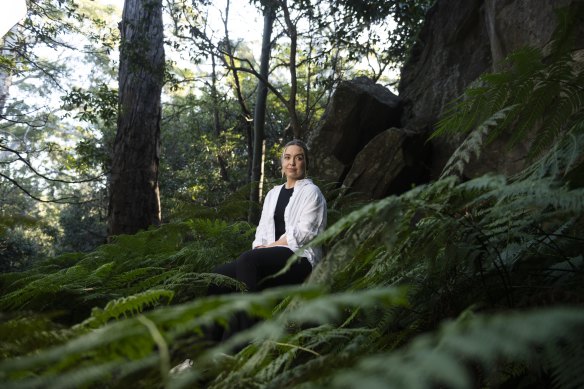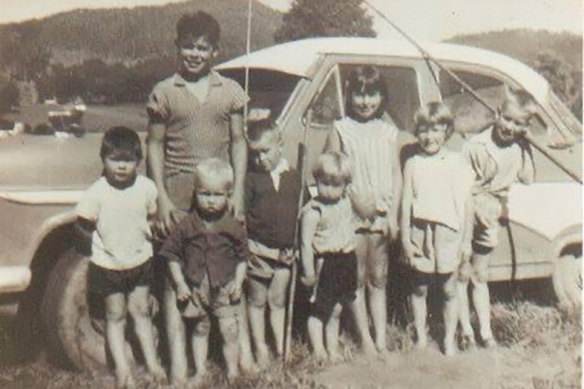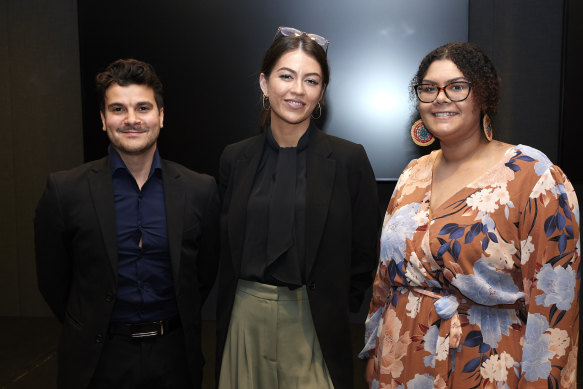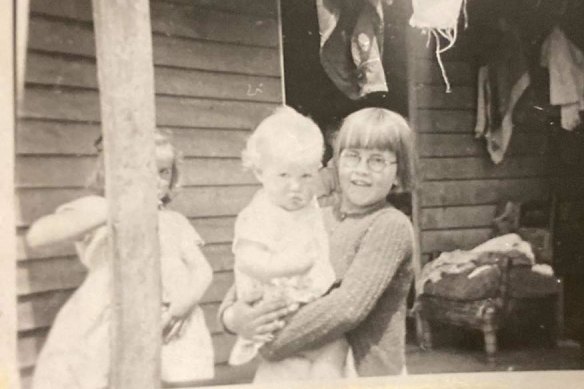- Exclusive
- National
- NSW
- Indigenous justice
This was published 1 year ago
We all know about the stolen generations. We didn’t always hear about those who opposed the law at the time
When NSW parliament debated Aboriginal child removals in 1915, they were talking about children like Kishaya Delaney’s great-grandmother in Wiradjuri country in western NSW.
The 1915 law expanded the power of the Aborigines Protection Board to “assume full control and custody” of some Aboriginal children.
Delaney’s ancestor who lived on Bulgandramine mission at the time, and the law was used to forcibly take her from her family a year later, at just 11 years old.

Kishaya Delaney found working on the Towards Truth project illuminated her own family history.Credit: Rhett Wyman
Delaney, 26, is a pro bono solicitor at Herbert Smith Freehills working on Towards Truth, an Indigenous truth-telling project that aims to contribute to the Uluru Statement of the Heart’s call for truth, alongside Voice and treaty.
The project, which aims to document all the laws and policies that have affected First Nations people since white colonisation, is a collaboration between the Public Interest Advocacy Centre and the UNSW Indigenous Law Centre led by Cobble Cobble woman Professor Megan Davis.
“This project is the first of its kind in Australia,” Davis says. “It’s setting the foundations of a serious and evidence-based era of truth-telling that will feed into the Australia historical narrative.”
Most Australians would be aware of the stolen generations, a systematic policy of child removal and forced assimilation for which former prime minister Kevin Rudd apologised in 2007.
It’s easy to write off policies of oppression and dispossession as the product of a less enlightened time. But Towards Truth makes it clear that these policies were hotly contested at the time, and there were contemporary voices of dissent all along.
It shows, for example, that while the 1915 law that affected Delaney’s family passed with a large majority, it was not unanimous.
The parliamentary record shows former ALP member turned independent Patrick McGarry was under no illusions about the cruelty of the policy “to steal the child away from the parents”, or the true motivation behind it.
“It is the mean settler who wants to get absolute control over these children to make them work for him,” McGarry told parliament. “He is supported by the mean policeman, who depends for promotion on the mean settler and mean squatter.”

Sally Treveton’s family in the 1950s. It depicts some of her grandmother’s siblings and visiting cousins. The great-uncle on the far left was removed from the family and sent to an institution for being ‘uncontrollable’.
McGarry said the non-Indigenous people had “overrun their country and taken away their domain” and there was further cruelty in separating children from parents.
He notes that while the law allowed parents to appeal a removal, an Aboriginal woman would have no one to put her case in court and little chance of success.
Davis, the pro-vice-chancellor Indigenous at the University of NSW and a prominent proponent of the Indigenous Voice to parliament, says these white dissenters are “the most important supporters of all”.
“You can’t be what you can’t see,” she says. “All of those non-Indigenous allies who are stepping up now, to support us and have our back, they mean everything.”
Besides McGarry, another example is from 1940, when upper house MP Mark Davidson, speaking for the leader of the opposition, compared the treatment of Aboriginal people in Australia with the treatment of minorities in Nazi Germany, and said the government “evidently desires their extinction”.
“As a result of the treatment that the Aborigines are receiving at the hands of the white people who took their country from them, they are fast becoming extinct,” Davidson said.
“The Aboriginal population of NSW has been dying out since the advent of the white man. They are in the minority, and it seems they are being treated as Hitler treats minorities on the other side of the world, although perhaps not so forcibly. They are being treated in a manner that will bring about their extinction.”
Davis says the call for truth is about telling a more inclusive version of Australian history that centres on the dispossession of the original inhabitants, including in the school curriculum.
Towards Truth starts by examining NSW history, but the ambition is to make it national. As well as sections on child removal, the site so far includes research on laws affecting Aboriginal languages, water rights, citizenship and court appearances.
Davis says the project is objective because it draws on the “bucketloads of law” recorded in the archives of the colonial parliaments and post-federation parliaments.
For Delaney, a Wiradjuri woman from Orange living in Sydney, being involved in the research helped her fill in gaps in her family history, especially about her great-grandmother’s life.
“We knew that she was sent off to work as a domestic servant, which was essentially a form of slavery, but we didn’t know why she was removed,” Delaney says.
“It was learning about the change in the law in 1915 that expanded the power to remove Aboriginal children just for being Aboriginal that made sense of why she was removed in 1916.
“We also didn’t know what happened to her siblings, but from learning about the policies they had at the time for assimilation, we now understand they were probably placed separately into children’s homes.
“When I started working on the project … I didn’t expect it to have such a huge impact on me and my perception of my identity.”

Towards Truth legal research officer Sally Treveton (centre) at the Towards Truth launch, with Towards Truth project co-ordinator Corey Smith (left), and Bridget Cama, UNSW Indigenous Law Centre associate.
After finishing her stint as a domestic servant, Delaney’s ancestor married a white man and did not talk about her Aboriginality. Delaney said the historical records show that Aboriginal girls were actively encouraged to marry white men once they completed their training, rather than return to their families. In the case of her great-grandparents, it was a loving and happy marriage.
Delaney’s family always knew they were Aboriginal, but her grandmother had a limited sense of her identity. It’s been left for younger generations, such as Delaney and her mother, to explore their heritage and culture more fully.
Delaney believes the site will make a valuable contribution to truth-telling, and will be “cathartic and healing” for a First Nations audience.
“Having evidence of something that actually happened that can be proven can give people something to connect the dots with their own memories and experiences,” she says.
Working on the project as a researcher was a similar experience for Birpai woman Sally Treveton, 25, from Port Macquarie and now living on the Gold Coast.
Treveton’s family were originally from Anaiwan country near Armidale, but moved to Port Macquarie in the 1950s. The local Birpai mob accepted Treveton’s grandmother and her siblings, to the horror of their father.
Treveton said her great-grandfather hid his Aboriginality, and might have had an exemption certificate. If so, this would have allowed him not to be subject to laws affecting Aboriginal people as long as he renounced his identity and did not practise culture.
Treveton said the research gave her a better understanding of why he hid his identity.

Sally Treveton’s grandmother as a child in the 1950s, holding a cousin. Her father tried to hide the family’s Aboriginality.
“At the time there was government regulation that denied basic human rights like being able to work and be paid for it, having freedom of movement and not being confined to a government camp, and not having your children taken away,” Treveton says.
“My family was hiding being Aboriginal because it was something you should hide if you wanted to have those rights.”
Her grandmother’s embrace of her Aboriginal identity meant Treveton and her mother also grew up connected to culture. Yet two of her grandmother’s siblings were removed from the family by the authorities – her brother was sent to an institution for being “uncontrollable” and the fate of her sister is unknown.
Treveton says she already had a general idea of the oppressive laws that had affected her family through the generations, but she was still surprised by how blatantly the ideas were expressed in the legislation and parliamentary debate.
Working on the project has also strengthened her support for the First Nations Voice to parliament, which will be put to a referendum later this year.
“Every day I look at laws that were made about Aboriginal people without Indigenous input, and the negative impacts of that,” she says. “So I guess every day, I’m seeing a case for a Voice to parliament.”
The Morning Edition newsletter is our guide to the day’s most important and interesting stories, analysis and insights. Sign up here.